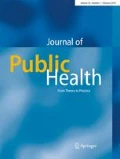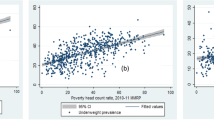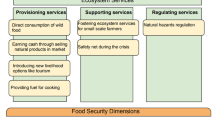Abstract
Aim
Eradication of child malnutrition is important to ensure the future of children and for its association with morbidity, mortality, and impaired childhood development. This paper investigates the influence of geographical context on child malnutrition by mapping the residual net effect of malnutrition while controlling for bio-demographic and socioeconomic risk factors simultaneously.
Subject and method
We used data from the publically available National Family Health Survey to investigate the important risk factors of childhood diarrhoea, fever and acute respiratory infection using Bayesian geo-additive semi-parametric models.
Results
The results indicate that geoaddative models are needed to adequately assess nonlinear covariates effects and geographic effects within a joint model. With a traditional regression model these effects are difficult to model and to detect. Further, there were considerable geographical variations in child malnutrition across states in India. It is spatially structured and rates remain very high in the central region in comparison to other regions of India. Malnutrition was significantly high for children suffering from diarrhoea, fever and acute respiratory infection. Further, sex, birth order, consumption of Vitamin A, breastfeeding, caste, religion and wealth quintile were found to have significant effects on malnutrition.
Conclusion
The findings suggest that both spatial effect and morbidity, including individual and household factors have significant impact on malnutrition among children. Understanding these relationships can facilitate design of intervention programs. Clearly tackling the problem of malnutrition in India will require multisectoral interventions, targeted at all levels of social organization.






Similar content being viewed by others
References
Adebayo SB, Yahya WB (2013) Modelling immunization coverage in Nigeria using Bayesian structured additive regression. In: Kandala NB, Ghilagaber G (eds) Advanced techniques for modelling maternal and child health in Africa, 2nd edn. Springer, Heidelberg, Germany
Arnold F, Nangia P, Kapila U (2004) Indicators of nutrition for women and children in India: current status and programme recommendations. In: Irudaya Rajan S, James KS (eds) Demographic change, health inequality and human development in India. Center for Economic and Social Studies, Hyderabad, India, pp 141–164
Bawdekar M, Ladusingh L (2008) Contextual correlates of child malnutrition in rural Maharashtra. J Biosoc Sci 40(5):771–786
Belitz C, Brezger A, Kneib T, Lang S (2009) BayesX: software for Bayesian inference in structural and additive regression models, version 2.0.1. R-Forge. bayesr.r-forge-project.org. Accessed June 2015
Belitz C, Hubner J, Klasen S, Lang S (2010) Determinant of the socioeconomic and spatial pattern of undernutrition by sex in India: a geoaddative semi-parametric regression approach. In: Tutz G, Kneib T (eds) Statistical modelling and regression structure. Springer, Berlin
Besag JE, York JC, Mollie A (1991) Bayesian image restoration, with two applications in spatial statistics. Ann Inst Stat Math 43(1):1–59
Borooah V (2002) The role of maternal literacy in reducing the risk of child malnutrition in India. Working Paper no. 31, International Center for Economic Research. http://eprints.ulster.ac.uk/9068/1/06PaperBorooah_OUP_Book.pdf. Accessed 12 December 2014
Brezger A, Lang S (2006) Generalised structure additive regression based on Bayesian P-splines. Comput Stat Data Anal 50:967–991
Eilers PHC, Marx BD (1996) Flexible smoothing with B-splines and penalties. Stat Sci 11(2):89–121
Fahrmeir L, Khatab K (2008) Geoaddative latent variable modelling of child morbidity and malnutrition in Nigeria. Technical report no. 020, University of Munich, Munich, Germany
Gayawan E, Arogundade ED, Adebayo SB (2014) Possible determinants and spatial patterns of anaemia among young children in Nigeria: a Bayesian semi-parametric modelling. Int Health 6(1):35–45
Goldstein H (1999) Multilevel statistical models, 1st Internet edn. Institute of Education, London
International Institute for Population Sciences (IIPS) ORC Macro (2007) National Family Health Survey (NFHS-3), 2005-06: India, vol 1. IIPS, Mumbai
Kandala NB, Lang S, Klasen S, Fahrmeir L (2001) Semiparametric analysis of the socio-demographic determinants of undernutrition in two African countries. Res Off Stat 4:81–100
Kandala NB, Magadi MA, Madise NJ (2006) An investigation of district spatial variations of childhood diarrhoea and fever morbidity in Malawi. Soc Sci Med 62(5):1138–1152
Kanjilal B, Mazumdar PG, Mukherjee M, Rahman MH (2010) Nutritional status of children in India: household socio-economic condition as the contextual determinant. Int J Equity Health 9:19
Khatab K, Fahrmeir L (2009) Analysis of childhood morbidity with geoaddative probit and latent variable model: a case study for Egypt. Am J Trop Med Hyg 81(1):116–128
Klasen S (1996) Nutritional, health and mortality in Sub-Saharan Africa: is there a gender bias? J Dev Stud 32(6):913–932
Lang S, Brezger A (2004) Bayesian P-splines. J Comput Graph Stat 13(1):183–212
Measham AR, Chatterjee M (1999) Wasting away: the crises of malnutrition in India. Report no. 19608, World Bank, Washington, DC
Mishra VK, Roy TK, Retherford RD (2004) Sex differential in childhood feeding, health care, and nutritional status in India. Popul Dev Rev 30(2):269–295
Nair KRG (2007) Malnourishment among children in India: a regional analysis. Econ Political Wkly XLII 37:3797–3803
Pathak PK, Singh A (2011) Trends in malnutrition among children in India: growing inequalities across different economic groups. Soc Sci Med 73(4):1–10
Pathak PK (2009) Socioeconomic inequality in malnutrition in India, 1992–2005. Paper presented at the annual meeting of Population Association of America (PAA), Detroit, MI, April 29–May 2 2009
Pelletier D (1998) Malnutrition, morbidity and child mortality in developing countries. In: Too young to die: genes and gender? United Nations, New York, pp 109–132
Pongou R, Ezzati M, Salomon JA (2006) Household and community socioeconomic and environmental determinants of child nutritional status in Cameroon. BMC Public Health 6:98
Rahman A, Chowdhury S (2007) Determinant of chronic malnutrition among preschool children in Bangladesh. J Biosoc Sci 39(2):161–173
Rajaram S, Zottarelli LK, Sunil TS (2007) Individual, household, programme and community effects on childhood malnutrition in rural India. Matern Child Nutr 3(2):129–140
Rao GR, Ladusingh L, Pritamjit R (2004) Nutritional status of children in north-eastern India. Asia-Pac Popul J 19(3):39–56
Rue H, Held L (2005) Gaussian Markov random fields: theory and applications. Chapman and Hall, Boca Raton, FL
Scrimshaw S, SanGiovanni JP (1997) Synergism of nutrition, infection, and immunity: an overview. Am J Clin Nutr 66(2):464S–477S
Sen A (1999) Development as freedom. Oxford University Press, Oxford
Smith L, Haddad L (1999) Explaining child malnutrition in developing countries. Working paper no. 111, IFPRI, Washington, DC. http://www.ifpri.org/sites/default/files/pubs/pubs/abstract/111/rr111.pdf. Accessed 20 December 2014
UNICEF (1998) The state of the world’s children. UNICEF, New York
UNICEF (2007) The state of the world’s children. UNICEF, New York
World Bank (2009) India overview. World Bank, Washington, DC
World Health Organization Multicenter Growth Reference Study Group (2006) WHO child growth standards: length/height-for-age, weight-for-age, weight-for-length, weight-for-height and body mass index-for age-method and development. World Health Organization, Geneva
Acknowledgements
An earlier version of this paper was presented at the Global Public Health Conference held at The School of Public Health, SRS University, India in 2014. The comments of the participants have facilitated in the revision of the paper.
Conflict of interest
The authors declare that there is no conflict of interest.
Contribution of authors
Awdhesh Yadav, Laishram Ladusingh and Ezra Gayawan conceived and designed, performed the experiments, contributed analytical tools and wrote the paper. Awdhesh Yadav analyzed the data.
Author information
Authors and Affiliations
Corresponding author
Rights and permissions
About this article
Cite this article
Yadav, A., Ladusingh, L. & Gayawan, E. Does a geographical context explain regional variation in child malnutrition in India?. J Public Health 23, 277–287 (2015). https://doi.org/10.1007/s10389-015-0677-4
Received:
Accepted:
Published:
Issue Date:
DOI: https://doi.org/10.1007/s10389-015-0677-4




